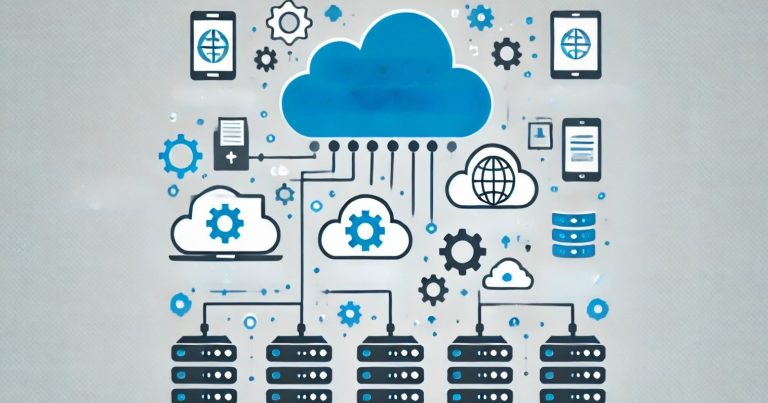Cloud technology examples are services and platforms that will help you store, manage and process data online instead of using local computers. Reengineered cloud technology enables applications, databases, and computing power to be used afar. Some widely used examples of cloud computing technology are Google Drive, Microsoft Azure, and Amazon Web Services (AWS). Cloud-native technologies help businesses scale operations, improve efficiency, and lower IT costs. How does Cloud Technology Understand types, and how does it work? For example, organizations optimize their digital solutions and improve their data.
What is Cloud Technology?
Cloud technology encompasses internet-provided computing services such as storage, processing, and networking. We no longer need to run everything in our physical environments where we live and work, but rather in cloud-based services where they are hosted much further away.
It has on-demand self-service, meaning users can access cloud services anytime and anywhere. Scalability means cloud resources can respond automatically based on demand without the cost associated with additional infrastructure, supporting the growth of the business.
Cost-effective solutions contribute to lowering IT costs by reducing the requirement for tangible hardware. Security and backup functions such as encryption and disaster recovery solutions help preserve the data, and are meant to ensure business continuity and protect sensitive data.
Cloud Technology Examples
Data storage, application hosting with security and many other needs are catered to by cloud computing, which is a ubiquitous technology spread through industries. Learn how businesses utilize cloud technology in the examples below: They are frequently used as case studies to ensure companies are achieving maximum efficiency, security and scalability.
Cloud Storage Services
Cloud storage services allow individuals to store, manage, and access files from any device connected to the internet. They offer people and organizations a secure and expandable storage solution. Here are a few providers: Google Drive — Free and paid plans for cloud storage; Dropbox — Real-time collaboration tool; OneDrive — Office 365 integration for file accessibility.
Cloud Computing Platforms
They just provide the on-site computing power, storage, and infrastructure for businesses or developers. Businesses use these services to run applications, process data, and deploy machine learning models without spending money on expensive hardware. Sample: AWS by Amazon is for cloud infrastructure, Microsoft Azure is for AI & analytics, and GCP (Google Cloud Platform) is for big data & storage.
Cloud-Based Applications (SaaS)
SaaS or Cloud-based application does not require installation on any local machine. Hence applications that allow business and individuals to collaborate, access files, and progress further on them are helping in overall improvements. Zoom: Video conferencing tool; Slack: Collaboration tool with built-in cloud storage; Salesforce: Cloud-based customer relationship management (CRM) software.
Cloud Security Services
WikipediaWhen it comes to cloud environments, cloud providers protect digital assets, applications, and data. These solutions serve to prevent companies from losing data, cyberattacks, breaches, and unauthorized access. Cloudflare DoS protection and McAfee Cloud Security encrypts data for protection. On the other hand, it is sharing safely, with every network event being analysed and reported by AI-enabled IBM Cloud Security for suspicious activity, particularly malicious data.
Cloud Gaming
Similar to streaming music, you can play video games online without needing to have expensive gaming hardware with cloud gaming. Gamers can instantly access and play games whereas traditional games need to in stored in physical disks. Examples include — Google Stadia, which streams games online; NVIDIA GeForce Now, which allows people to play PC games running in the cloud; and Xbox Cloud Gaming, a Microsoft service for cloud-based gaming.
Platform as a service(PaaS)
Platform as a Service (PaaS) is a type of cloud computing service that provides a platform for developers to build, test, and deploy applications from the cloud. These services reduce the complexity of app development by managing infrastructure, networking, and database provisioning. Examples: Heroku for app deployment, Red Hat OpenShift for a Kubernetes-based cloud application platform and Firebase is Google’s mobile and web app development platform.
Types of Cloud Computing
There are multiple cloud computing models, which can be categorized based on deployment and services. Following are some types of Cloud computing: (Public cloud, Private cloud and so on)
Public Cloud
Public cloud services host data on servers and storage that are available over the internet to the general public. These services allow businesses and individuals to use these services without investing in physical infrastructure. Examples: cloud providers (AWS, Google Cloud, Azure), serverless architectures, etc.
Private Cloud
The former are private and are provided to only a single organization, making it more secure with control over data. These clouds are perfect for businesses managing sensitive information that require stringent regulatory compliance. Example: VMware Private Cloud enables enterprises to manage workloads efficiently within a secure and customizable cloud environment.
Hybrid Cloud
A combination of on-premises (private cloud) and public cloud solutions for flexibility and more efficient resource management. Hybrid Cloud setups enable organizations to find a balance between security and scalability while also optimizing costs. IBMHybrid Cloud allows enterprises to store their critical data in an enterprise private cloud while using the public cloud to manage business surge and demand, for instance.
Multi-Cloud
Multi-cloud solutions take advantage of the cloud providers to offer better performance, avoid vendor lock-in, and to encourage redundancy. Business Needs Cloud Platforms (030) 5 Comments cloud usage in business 5 Comments */ One example for cloud solutions for enterprises is available for different services where corporations use the AWS (Amazon Web Services) storage facilities, they use Google Cloud for AI features, and easily connect everything.
Advantages of Cloud Technology
Businesses and individuals benefit in several waysfrom the cloud technology. Cloud computing is changing how business works, because it provides flexibility, security, and efficiency.
- Cost Saving: It lowers the cost of IT infrastructure & Maintenance. The pay-per-use model enables businesses to optimize their expenses and avoid waste, eliminating the need for expensive hardware investments
- Scalability: Resources in the cloud grow with or shrink from overflowing. No need to invest in additional infrastructure to support business growth. Companies can scale immediately at zero downtime and with no major upgrades.
- Security & Compliance: Data is stored in an encrypted manner and complies with global regulations. Cloud security services guard against cyber threats regular security updates protect users from sophisticated cyber threats.
- Increased Remote Access & Collaboration: Employees can work from anywhere with cloud applications. Sharpen productivity through live file updates and collaboration. Seamless access to cloud-based tools enhances the efficiency of remote teams.
- Disaster Recovery & Backup: Automates data backup to avoid loss. Provides business continuity in the event of failures. Cloud service-based backups allow for speedy restoration of systems post-crash or cyber incidents.
- Quicker Deployment of Applications: With cloud platforms, developers can deploy applications in less time. It may significantly reduce the time to market for new software products. Cloud computing makes testing, updates, and product improvements faster.
How Cloud Technology Works?
Cloud computing streamlines IT operations and improves digital transformation. Few are as follows cloud infrastructure, internet connectivity, cloud survival models etc.
- Cloud infrastructure: Cloud computing runs on data centres with virtual resources. Stores and retrieves data on a distributed server. This configuration streamlines processes and minimizes enterprises’ reliance on hardware.
- Internet Connectivity: The users access Cloud services via web browsers and applications. Ensures that you stay connected to all your devices. It improves the application’s user experience and the cloud service’s performance.
- Cloud Service Models: Organizations choose IaaS, PaaS and SaaS as per their needs. Apps without local installation run on cloud platforms. The right model will help optimise costs and operational efficiencies.
- Security and Encryption: Cloud providers employ encryption and authentication protocols. Data is stored securely and can be backed up and recovered automatically. Regular updates ensure that we are protected against all possible cyber threats or unauthorised access.
- Resource Scaling & Load Balancer: The cloud computes resource scales automatically based on demand. It guarantees continuous delivery without interruption. Load balancing efficiently distributes network traffic without overburdening the system.
Relevance to ACCA Syllabus
Cloud technology is becoming increasingly pertinent to the syllabus for Strategic Business Leader (SBL) and Financial Management (FM) within ACCA. Professionals at ACCA need to know how cloud-based accounting, enterprise resource planning (ERP) systems and financial reporting tools are discontinuing business modalities. Accountants and auditors must stay up to date on software as a service (SaaS), cloud storage solutions, and cybersecurity in the realm of cloud computing.
Cloud Technology Examples ACCA Questions
Q1: Which of the following is a cloud based accounting software?
A) QuickBooks Online
B) Microsoft Excel
C) Notepad++
D) IBM SPSS
Ans: A) QuickBooks Online
Q2: What is one of the most important benefits of using cloud technology to manage finances?
A) With all all-time availability of financial information from anywhere
B) Eliminates the need for auditing
C) It limits financial data to only one device
D) It diminishes the significance of financial reporting
Ans: A) With all all-time availability of financial information from anywhere
Q3: The following is an example of cloud-based enterprise resource planning (ERP) software?
A) SAP S/4HANA Cloud
B) Tally ERP (Offline)
C) Manual Ledger Books
D) Microsoft Paint
Ans: A) SAP S/4HANA Cloud
Q4: What are the benefits of cloud computing in financial risk management?
A) Providing backup as well as disaster recovery solutions
B) By keeping financial data permanently on local devices
C) By removing cybersecurity protections
D) By eliminating data encryption
Ans: A) Providing safe backup and disaster recovery solutions
Q5: What option is under the guise of cloud storage service that is a good usage in financial organizations?
A) Google Drive
B) Microsoft Word
C) Adobe Photoshop
D) Windows Notepad
Ans: A) Google Drive
Relevance to US CMA Syllabus
US CMA syllabus strategic management, performance measurement & information systems — cloud technology. CMAs need a thorough grasp of how cloud-based financial software, business intelligence tools, and automation technologies enhance cost control, risk absorption, and decision-making.
Cloud Technology Examples CMA Questions
Q1: Which of the following is a cloud based financial planning software?
A) Adaptive Insights
B) WordPad
C) Windows Calculator
D) CorelDRAW
Ans: A) Adaptive Insights
Q2: How can Software as a Service (SaaS) help management accountants?
A) Offers access to financial software on a flexible subscription basis.
B) It absolves you of budgeting
C) It limits automation in accounting
D) It inhibits financial reporting on a real-time basis
Ans: A) Offers access to financial software on a flexible subscription basis
Q3: What contribution is cloud-based analytics software providing to support management accountants?
A) Through real-time data visualization and performance tracking
B) Removing the ability to store the data in a remote server
C) By doing away with forecasting
D) By limiting data reporting
Ans: A) Through real-time data visualization and performance tracking
Q4: Identify below an example of cloud-based business intelligence (BI) software.
A) Microsoft Power BI
B) Lotus 1-2-3
C) Typewriter Machines
D) Manual Paper-Based Reports
Ans: A) Microsoft Power BI
Q5: In what ways does cloud computing provide cost control for businesses?
A) Reduces IT infrastructure cost and enhances efficiency
D) It abolishes financial planning requirements
C) It creates dependency on manual record-keeping
D) It restricts data access
Ans: A) Reduces IT infrastructure cost and enhances efficiency
Relevance to US CPA Syllabus
Cloud technology relates to the Audit & Attestation (AUD) and Business Environment & Concepts (BEC) sections of the US CPA syllabus. With the relevance of remote work and cloud, CPAs should grasp how each of these impacts the effectiveness of financial reporting and internal control systems and processes.
Cloud Technology Examples CPA Questions
Q1: Which of the following cloud technologies is commonly used for automated financial audits?
A) CaseWare Cloud
B) Adobe Photoshop
C) Legacy Excel Spreadsheets
D) Typewriters
Ans: A) CaseWare Cloud
Q2. What is a main worry for auditors with cloud accounting systems?
A) Cybersecurity threats and data integrity
B) Please list significant regulatory compliance requirements that have been reduced
C) Not advanced technologically
D) Remove the financial statements
Ans: A) Cybersecurity threats and data integrity
Q3: What is the effect of cloud-based accounting on financial reporting?
A) Enables live reporting, increases accuracy
B. It restricts accountants from accessing financial data from remote locations
C) It removes audit requirements
D) It restricts compliance with accounting standards
Ans: A)Enables live reporting, increases accuracy
Q4: What cloud technology is most often used in automated tax compliance?
A) Avalara
B) Adobe Illustrator
C) Lotus Notes
D) Pen-and-paper bookkeeping
Ans: A) Avalara
Q5: What does cloud-based audit analytics software primarily do?
A) For example to discover anomalies and fraud risks in large quantities of financial data.
B) So there are no prospective financial controls
C) Avoid digital recordkeeping of financial records
D) Eliminating tax compliance processes
Ans: A) For example to discover anomalies and fraud risks in large quantities of financial data
Relevance to CFA Syllabus
The CFA syllabus discusses cloud technology in corporate finance, risk analysis, and investment analytics. CFA professionals must grasp how technologies like cloud-based trading systems, financial risk management software or portfolio analytics tools, facilitate richer investment decision-making.
Cloud Technology Examples CFA Questions
Question 1: Which cloud-based professional trading platform is used by most investors?
A) Bloomberg Terminal
B) MS Paint
C) Notepad
D) Yahoo Messenger
Ans: A) Bloomberg Terminal
Q2: In what way can financial risk assessment benefit instead from the adoption of cloud computing?
A) Providing Risk analytics and monitoring in real-time
B) Because it doesn’t allow for real-time updating of financial data
C) Now that risk management procedures have been eliminated
D) By restricting access to financial data
Ans: A) Providing Risk analytics and monitoring in real-time
Q3: Identify the cloud-based tool that facilitates investment research and financial modeling:
A) FactSet
B) Microsoft Word
C) Windows Media Player
D) CorelDRAW
Ans: A) FactSet
Q4: How does this new state of the art cloud-based financial software create an effect on the investment management aspect?
A) It allows us to monitor portfolios in parallel and trade automatically
B) It hampers investors from making sense of the market
C) Increases dependency on manual stock calculations
D) It removes the monitoring of financial performance
Ans: A) It allows us to monitor portfolios in parallel and trade automatically
Q5: One of the most common cloud services used by these investment firms to store their financial data and backup is?
A) Amazon Web Services (AWS)
B) MS Paint
C) Physicians office filing cabinets
D) Pocket Calculators
Ans: A) Amazon Web Services(AWS)


